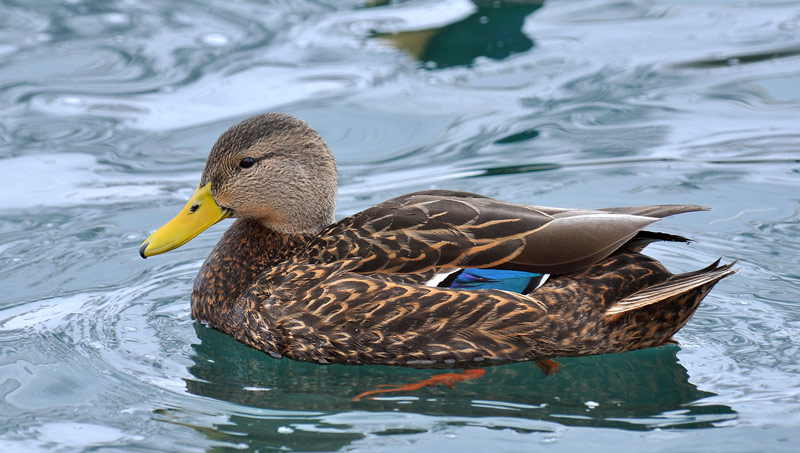 |
||
| Common name: |
Mexican Duck, Mexican Mallard |
|
| Scientific name: | Anas (platyrhynchos) diazi | |
| Date: | 5 Feb 2012 and 19 Feb 2012 | |
| Time: | 12:50 PM and 2:30 PM | |
| Length of time observed: | 30 min each time | |
| Number: | 1 | |
| Age: | adult | |
| Sex: | male | |
| Location: | First Dam, Logan | |
| County: | Cache | |
| Latilong: | ||
| Elevation: | 4670 ft. | |
| Distance to bird: | Down to 8 ft. | |
| Optical equipment: | Nikon Monarch 10x42 binoculars, Nikon D90 with 80-400mm lens. | |
| Weather: | ||
| Light Conditions: | ||
| Description: Size of bird: | Appeared slightly smaller than nearby Mallards. | |
| (Description:) Basic Shape: | Duck shape | |
| (Description:) Overall Pattern: | Darker than female mallards | |
| (Description:) Bill Type: | Duck bill, bright yellow with black nail. | |
|
(Description:)
Field Marks and Identifying Characteristics: |
See photographs. This duck looked to me like
close to a pure Mexican Duck. The tail was very dark, with no white patches. The
rump seemed concolor with the back and flanks, not noticeably darker. (It does
look darker in one or two photos, but I believe this was an effect of shading
from the wingtips. When directly illuminated, it did not look darker.) The white
at the front and back of the speculum was rather limited. The belly was not
paler than the flanks or breast. The speculum had a greenish, not purplish sheen
at most angles which has been reported by Scott and Reynolds 1984 as the most
useful feature in distinguishing Mallards from Mexican Ducks. The central retrices (tail feathers) lifted up just slightly, not looping around like that of a Mallard's, but rising just subtly off the plane of the other tail feathers. To be completely precise, I believe the slightly uplifted central retrices indicated some limited Mallard heritage in this individual. I have considered this to be a "pure" Mexican Duck for my listing purposes because I feel this bird is much closer to pure than to a first-generation hybrid. That is, this bird is probably more than 95% Mexican Duck, and less than 5% Mallard, but there is a small Mallard component to this duck. If Mexican Duck ever becomes a recognized species according to the UBRC, the committee will have to wrestle with how pure an individual has to be to be "counted." For what it's worth, Rich Stallcup, expert birder from California and guide of many WINGS tours in Mexico, said in a personal email to Andy Kleinhesselink, regarding this individual, "From what I recall (and that is a lot of Mexican Ducks) your bird looks as good as it gets." |
|
| Song or call & method of delivery: | None noted specifically to come from this individual. Many vocal ducks were present. | |
| Behavior: | Loafing and feeding on bread with other ducks, including wild Mallards and domestic "park duck" Mallards. | |
| Habitat: | Small reservoir at a city park. | |
| Similar
species and
how were they eliminated: |
American Black Duck: Eliminated by plumage not dark enough and too rufous, and
thin but distinct white borders to the speculum. Mottled Duck: Eliminated by lack of a black spot at the gape and details of plumage (see photos). See description above for assessment of purity (i.e., elimination of Mallard hybrid). |
|
| Previous
experience with this & similar species: |
This is my third observation of a Mexican Duck, with both others in the San Simon Valley of extreme southeast Arizona. I have seen American Black Ducks on several occassions. I have not seen a Mottled Duck. | |
| References consulted: | ||
| Description from: | From memory | |
| Observer: | Ryan P. O'Donnell | |
| Observer's address: | 1098 Crescent Dr, Logan | |
| Observer's e-mail address: | Tsirtalis@hotmail.com | |
| Other observers who independently identified this bird: | Craig Fosdick, Andrew Durso, Andy Kleinhesselink, and Guillaume Peron. | |
| Date prepared: | 20 Feb 2012 | |
| Additional material: | Photos | |
| Additional comments: |
Submitted as a "Special Sighting". Currently considered a subspecies of Mallard
according to the ABA and AOU (and thus not reviewable by the UBRC), but I
believe those organizations may follow the IOC and elevate this taxon to species
status at some point in the future. This is probably the third individual of
this taxon in Utah; Rick Fridell has photographed two in Washington County, one
of which was also photographed by Rich Young). To help eliminate a domestic origin of this bird, it is worth noting that the bird was not banded. |
|